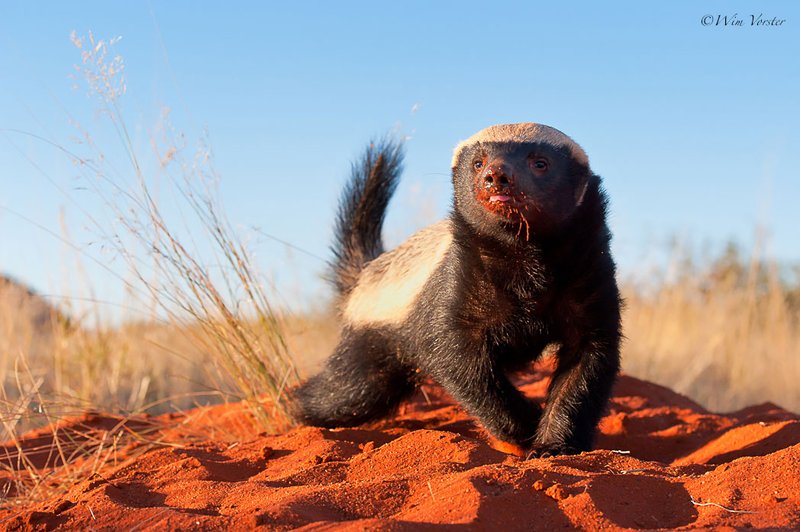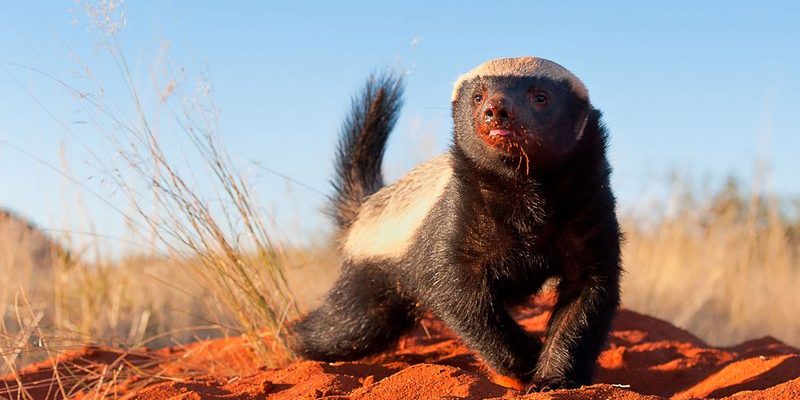
The honey badger, known for its fearless attitude and remarkable resilience, is one of nature’s most fascinating creatures. Imagine a small, stout mammal that seems to have a personality larger than life itself. It’s as if this little warrior decided that fear had no place in its world. With a reputation for being tough and unyielding, the honey badger has captured the hearts of animal lovers and scientists alike.
You might be surprised to learn that the honey badger, or Mellivora capensis, is not just a badger. It belongs to its own unique family, the Mellivoridae, which places it alongside weasels and otters. Found across Africa, parts of the Middle East, and in some areas of Asia, this remarkable animal showcases a mix of adaptability, strength, and intelligence. But what makes the honey badger truly unique? Let’s dive deeper into its world.
Physical Characteristics
The honey badger is a small but mighty animal, with adult individuals typically weighing between 20 to 30 pounds and measuring around 20 to 30 inches in length. This compact build is complemented by a stocky body, short legs, and a broad head. Its rugged appearance is further enhanced by thick, loose skin which provides protection against bites and stings—an essential trait for an animal that dares to take on deadly creatures.
One of the most striking features of the honey badger is its fur. It sports a grayish-brown coat that helps it blend into its environment. But the most famous characteristic is its distinctive white patch running from the back of its head down to its back. This unique marking is like a badge of courage, showcasing the honey badger’s bold personality.
Additionally, honey badgers have sharp claws that can grow up to 1.5 inches long. These claws are vital for digging and are equally useful for climbing trees. Interestingly, their strong, muscular bodies give them remarkable dexterity, enabling them to manipulate their surroundings with ease. This combination of features makes every honey badger a formidable presence in its habitat.
Habitat and Distribution
Honey badgers are incredibly versatile when it comes to habitat. They can thrive in various environments ranging from savannas, forests, and grasslands to semi-deserts. These little warriors are primarily found throughout Africa, but you might also spot them in parts of the Middle East and even India. Their adaptability to different ecosystems is nothing short of amazing.
Let’s talk about their homes. Honey badgers prefer to dig their own burrows or take over existing ones created by other animals. These burrows provide shelter from harsh weather and predators while also serving as a safe place to raise their young. Interestingly, they are known to be solitary animals, although males and females come together during the mating season.
While many animals are sensitive to changes in their environment, honey badgers are quite the opposite. They have a wide range, which allows them to roam across territories in search of food, often covering several kilometers in a single night. Their tenacity and bravery enable them to adapt to various surroundings, and this resilience plays a crucial role in their survival.
Diet and Hunting Habits
When it comes to food, honey badgers are opportunistic eaters. Their diet mainly consists of small mammals, birds, insects, and even reptiles. They have a notorious penchant for honey, which is how they got their name. Imagine a little badger scaling trees or going head-to-head with a swarm of angry bees just to get a taste of that sweet, sticky treasure! It’s sheer bravery that drives them.
One of their remarkable hunting strategies involves using their strong claws to dig out prey from burrows. They can swiftly unearth snakes, rodents, and other critters hiding underground. Even more impressive, honey badgers are known to eat venomous snakes. Yes, you heard that right! They have a resistance to snake venom, allowing them to take on creatures like cobras with considerable confidence.
But their hunting doesn’t stop there. Honey badgers also display incredible intelligence when it comes to finding food. They often team up with other animals, like the greater honeyguide bird, which helps lead them to bee nests. Together, they create a partnership that benefits both species. The badger gets a tasty meal, while the bird can feast on leftover wax and larvae. It’s teamwork that showcases nature’s creativity!
Behavior and Social Structure
The honey badger is known for its independent spirit and fierce attitude. While they are primarily solitary animals, they are not completely antisocial. Males and females will come together during the mating season, and mothers raise the young on their own. Once the cubs are old enough to fend for themselves, they venture out on their own, exploring the world just like their fearless parents.
What makes the honey badger particularly interesting is its penchant for curiosity. These little creatures are known to investigate their surroundings thoroughly. Whether it’s an intriguing sound or a new smell, honey badgers approach these mysteries head-on, often leading to unexpected encounters with other wildlife. Their fearless nature allows them to take risks that many other animals avoid.
Moreover, honey badgers communicate using a variety of sounds, including growls, hisses, and even a unique vocalization akin to whining. This array of vocalizations helps them express their emotions or convey messages to other honey badgers. When confronted by threats, these fearless creatures will not hesitate to stand their ground, often displaying aggressive postures to ward off potential attackers. It’s this combination of curiosity and bravery that makes them such fascinating animals to observe.
Conservation Status
The honey badger is currently listed as Least Concern by the International Union for Conservation of Nature (IUCN). Despite their resilient nature, habitat loss and human encroachment pose potential threats to their populations. As urban areas expand, these magnificent animals face challenges in finding safe spaces to thrive.
In some regions, honey badgers may be hunted or trapped due to their reputation for raiding livestock. This has led to a decline in certain local populations, sparking conservation efforts to ensure their survival. Education and awareness campaigns play an essential role in promoting cohabitation with these creatures. Understanding that honey badgers are vital to their ecosystems can help mitigate conflicts between them and humans.
Additionally, organizations are working to protect their habitats and promote sustainable practices that benefit both wildlife and local communities. By fostering a more harmonious relationship between humans and honey badgers, we can ensure that future generations will continue to marvel at these tenacious creatures.
| Common Name: | Honey Badger |
| Scientific Name: | Mellivora capensis |
| Size: | 20 to 30 inches (50 to 75 cm) |
| Weight: | 20 to 30 pounds (9 to 14 kg) |
| Habitat: | Savannas, forests, grasslands, semi-deserts |
| Diet: | Insects, small mammals, birds, reptiles, honey |
| Lifespan: | Up to 14 years in the wild |
| Conservation Status: | Least Concern |
FAQ
What makes the honey badger so fearless?
The honey badger’s fearlessness can be attributed to its thick skin and tenacious attitude. This combination allows it to take on predators much larger than itself, such as lions or hyenas. Their aggressive behavior and loud vocalizations also deter potential threats. Simply put, the honey badger is equipped with both physical traits and a bold personality that make it a formidable animal.
Are honey badgers social animals?
While honey badgers are primarily solitary creatures, they do exhibit social behavior during mating seasons. Males and females come together briefly for reproduction, and mothers care for their young on their own. Honey badgers can also be seen interacting with other species, creating unique partnerships, especially when it comes to hunting for food.
Can honey badgers swim?
Yes, honey badgers are capable swimmers! They can navigate through water when necessary, whether it’s to escape danger or pursue prey. Their versatile physique allows them to adapt to various situations, showcasing their resilience and determination to survive in different environments.
Do honey badgers have any natural predators?
Interestingly, adult honey badgers have few natural predators due to their fierce reputation. However, young honey badgers may fall victim to larger animals like eagles or lions. Their ability to defend themselves and their thick skin make them less appealing targets for most predators.
How do honey badgers defend themselves?
Honey badgers have several defense mechanisms. Their thick skin protects them from bites and stings, while their sharp claws are perfect for digging and climbing. When threatened, they will puff up their bodies and hiss loudly, displaying aggression. If pressed further, they are not afraid to attack, using their strength and agility to fend off attackers.
What role do honey badgers play in their ecosystem?
Honey badgers play a crucial role in their ecosystem as both predators and scavengers. By keeping populations of small mammals and insects in check, they help maintain a balance in their environment. Their foraging also contributes to soil aeration, benefiting plant growth. Through these activities, honey badgers are essential for a healthy ecosystem.
Are honey badgers dangerous to humans?
While honey badgers are not typically a threat to humans, they can act defensively if threatened or cornered. Their fierce nature and strong bite can pose a risk if they feel endangered. It’s always best to respect their space and admire these remarkable animals from a distance.
How do honey badgers communicate?
Honey badgers communicate using a range of vocalizations, from grunts and growls to hisses. They may also use body language, such as posturing and movement, to convey their feelings or intentions. These communication methods help them interact with each other and establish social dynamics.
What do honey badgers eat?
As opportunistic feeders, honey badgers have a diverse diet that includes insects, small mammals, birds, and reptiles. They are particularly known for their love of honey, making them unique among predators. Their food choices can vary based on availability, showcasing their adaptability as foragers.
How long do honey badgers live?
In the wild, honey badgers typically live up to 14 years. Factors such as habitat quality, food availability, and human interaction can all influence their lifespan. In captivity, with proper care, they may live even longer, gaining protection from environmental threats.
Do honey badgers form family groups?
Honey badgers are generally solitary animals, but mothers will form a bond with their cubs for the duration of their upbringing. Once the young are old enough to fend for themselves, they leave to establish their own territories. Though they are not social animals, occasional interactions between individuals occur, especially during mating seasons.

